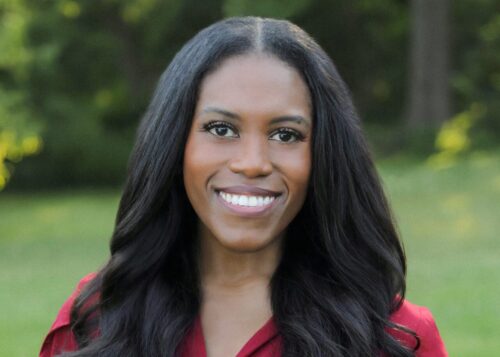'This Is an Everybody Problem': Esther Choo on Diversity, Equity, and Gender Bias in Healthcare
July 22, 2019
By Amanda Doyle

Getty Images
The emergency physician and TIME'S UP Healthcare founding member shares her perspective from the front lines of the equity fight.
In 2017, the nation saw a growing #MeToo movement and the subsequent rise of TIME’S UP, a national organization that advocates for safe, fair, and dignified working conditions for women. Originally devoted to exposing the abuse and sexual misconduct of powerful men in Hollywood, the platform has since branched out to address gender inequalities in male-dominated industries like tech and advertising.
This year, the organization welcomed the affiliated launch of TIME’S UP Healthcare. While women make up an overwhelming majority of the healthcare workforce, their representation in leadership positions continues to fall short. One memorable study highlighted disparities in healthcare leadership and wryly concluded that men with mustaches still outnumbered the women of any kind in medical department leadership. More seriously, research shows that patient outcomes and survival are at risk when women aren’t well represented within the care team.
TIME’S UP Healthcare founding member Esther Choo, MD has been an outspoken and charismatic leader for the organization, calling attention to the lack of women in leadership positions and coining phrases such as “mantoring,” a reference to the pattern of men who mentor only other men.
In a recent interview, Choo discussed her goals with TIME’S UP, her approach to advocacy, and why conquering this topic is really about building on the strengths of healthcare organizations.
HealthCity: You’ve been attacked on social media for sharing your views on gender and racial issues in healthcare. What do you think is behind those attacks?
Esther Choo, MD: It’s unavoidable now in healthcare to encounter these topics — and we can talk light about them, or we can talk deep. I find that when we get close to questioning the fundamental structure and culture of things, that’s when people start to feel really uncomfortable.
That discomfort comes out in a lot of different ways. Some of it is really maladaptive, and even violent and threatening. But I think it all reflects the same thing — when we ask some of these fundamental questions, a lot of people feel uncomfortable. And you want to aim for the discomfort if you really want change.
Are there dynamics specific to healthcare organizations that contribute to harassment or a lack of equity?
Well, I think we are very traditional organizations. And there are ways in which healthcare is set up to have really steep vertical hierarchies. It remains very male dominated. People sometimes compare healthcare institutions to the military — you know, we use a lot of military language when we talk about training and how you go through your career. That kind of male-dominated vertical structure is the environment in which we know harassment thrives.
The other part is that there’s so much contact between people of all roles. In the healthcare workforce, it’s a high surface area of interaction with other people, not just your colleagues and your supervisors. And then on top of that, hospitals are 24/7 environments. A lot of people working at odd hours. There are plenty of dark rooms where misconduct can occur and go unnoticed.
What does TIME’S UP Healthcare expect from signatory organizations?
Ultimately, signing on is an open acknowledgement to the community and to their workforce that addressing gender issues is a high priority. What we hope is that organizations that have stepped forward and declared that this is a high priority will continue to behave like it is. With something as a top strategic priority in any other sense, there are resources, and attention, and engagement of the community, and quality metrics and specific targets. And we hope to see all of those things from our signatory organizations.
The contrast between us being extremely effective professionals in one scenario and then being almost helpless and dumbfounded in this other area is really striking.
We don’t apply the same standards or rigor to solving the problem of harassment and inequity as we do to almost everything else in healthcare. We’ve developed entire frameworks to ensure that our clinical processes are delivered to the top of our ability. We’re capable of beating a single piece of care encounter to death with the amount of root cause analysis and granular dissection of what happened from minute to minute — and then we get to these fundamental, cross-cutting workforce issues that affect every single person in that institution, and we fall apart in terms of processes. The contrast between us being extremely effective professionals in one scenario and then being almost helpless and dumbfounded in this other area is really striking.
What would you say to people who think a younger generation of leaders will solve this problem?
I think it’s important that we not wait. The truth is, people adapt to the culture pretty quickly. I’ve been very surprised when I’ve brought in some assumptions about the generational divide at how much even professors emeritus can really embrace these issues when they choose to engage with them.
The urgency also is not just for the workforce. I really see this fundamentally as a patient care issue that relates to the quality and safety of the healthcare that we provide. Seen from that lens, it needs to start, like, yesterday — because we all are prioritizing what happens to our patients. I no longer can separate out workforce issues from patient care issues. My gut feeling around that is just that I can’t wait on any of these things anymore.
Tackling systemic issues like this can feel daunting. How can people begin?
One thing I always say to people who want to be part of the solution is that we all mind our own gates. I know what I have control over. I have my own research team, I have my own networks of healthcare providers and my own personal relationships. Every day I just wake up and think, “Everything that I have control of, I am going to carry the principles of my work into that and be explicit about them.”
If everybody who wants to help really minds their gate carefully, that’s a million small gates. I’d say focusing on solutions within our power to execute is the right mental space to be in. And then every now and then, we need to lift up our heads and look at somebody’s work-level issues and contribute something small to those as well.
You do a lot of speaking engagements on these topics. Have you noticed any trends in who’s most receptive to your message?
I’m pleased that it seems to be catching on to some extent everywhere. Although we have a lot of work to do, there has never been more momentum about these topics of safety and equity and workforce engagement than there is now. It includes not just large and prominent healthcare organizations, but really some of these large and influential national healthcare organizations like the AAMC and other groups.
Five or seven years ago, if you said, “Hey, does anybody want to talk about this?” — there were crickets. Now, those of us who are on the speaking circuit for these topics are flooded with requests for these talks. And when you go, there’s high participation and engagement.
There are things that I wish would change: When I give a talk about gender equity, it would be nice if the audience was more than a vast majority of women, if there was more diversity in the room. But still, there’s energy around these topics. I think that is highly encouraging.
How do we get more men in the room?
We just need to continue to talk about this as an everybody problem. The end point as I see it is patient care outcomes, and that is not something that just women care about. It’s the entire healthcare workforce, and all of its leadership should care about that.
The end point as I see it is patient care outcomes, and that is not something that just women care about.
Across corporate America, including in healthcare institutions, there’s actually a strong business case for diversity, equity, and safety. I think we just need to continue to talk about this as a patient-centered issue, as a very strong investment that’s likely to have a high return. By messaging like that and orienting everybody around these fundamental outcomes that we want downstream, I think we can start to engage basically everybody.
What does success look like for you?
I think it’s normalizing these conversations so they don’t feel so uncomfortable, creating the expectation that these conversations should occur on a regular basis, and knowing that we can sit around and problem solve around this, just the way that we do for other things. The day when people can sit around a case conference and talk about culture change with the same passion that they can talk about a clinical topic is the day we will have succeeded.
This whole movement is not meant to be punitive. It’s meant to help well-intentioned organizations to excel more. There is an exciting opportunity here to say as a healthcare community, Let’s rock this, let’s be centers of excellence in terms of how we treat our workforce. I would love to see the conversation tilt towards “How do we excel?” not “How do we not be terrible?”
This interview has been edited and condensed.


